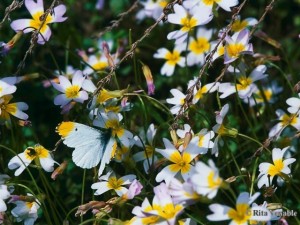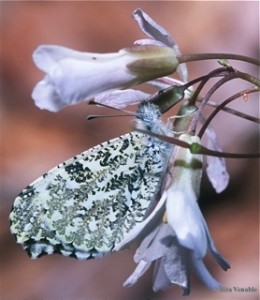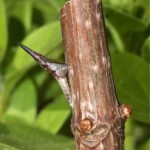Falcate Orangetips (Anthocharis midea) are signature spring butterflies across the Tennessee landscape. As the woodlands become dotted with spring wildflowers in March, look for Falcate Orangetips flying among the flowers. Above, both males and females are mostly white, but males have bright orange wingtips, which you can see as they fly. Their forewing wingtips are slightly hooked (falcate) and have checkered borders. Below, the hindwing is gray and white speckled. They fly from about March 1 until the middle of May.

Falcate Orangetips like sunny spots in moist, rich woods where spring wildflowers, especially their hostplants, are abundant. They are drawn to lake and creek trails and even open swamps. Falcates may also be found on dry ridgetops, bluffs, rocky outcrops, and along roadsides, paved or unpaved, where wildflowers grow.
Females lay single, pale eggs which turn orange and look like tiny footballs with ridges. Eggs are laid on plants in the mustard family, mainly toothworts, rock cresses and bittercresses. Caterpillars are bluish-green with a broad white stripe on the sides and a yellow stripe on the top. There are black dots all over, and the head is bluish-green.


Chrysalises are light brown, covered with black dots, and look like thorns. Falcate Orangetips remain as chrysalises summer, fall, and winter, emerging the next spring.
For your garden, provide cutleaf toothwort, which grows statewide. Toothwort provides both nursery and restaurant for the Falcates. These toothworts have lovely, light pink flowers and like rich soil and dappled sunlight. Good nectaring plants are spring beauties, violets, bluets, and glade sandwort.
Spring wildflowers and Falcate Orangetips, blessed messengers of spring, are ephemeral, so enjoy them while you have the opportunity. Look low, a foot or two above the ground, where most of their lives are lived. When you see them, stop a moment and relish the sight. Store the images in your mind like canned goods in your kitchen cupboard. Then, open these memories on a chilly day in February when you are hungry for spring.
©Rita Venable 2013